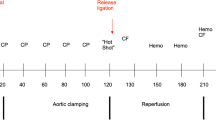Abstract
Objective: Coronary occlusion in the rabbit reduces the delivery of particulate tracers to close to zero, but exchange of diffusible solutes, derived from non-arterial sources, continues at a significant level. We investigated the relationships between the exchange of diffusible solutes during coronary occlusion and the extent of myocardial necrosis and between duration of ischaemia and the extent of recovery of solute exchange during reflow.
Methods: In an anaesthetised rabbit model of regional ischaemia and reflow, solute exchange is measured using the voltammetric hydrogen clearance technique. The area at risk and infarct size are determined ex vivo with monastral blue and nitroblue tetrazolium staining, respectively. Three groups are studied: control perfusion for 130 minutes (group A); 30 minutes coronary ligation followed by 90 minutes reflow (group B) and 40 minutes coronary ligation followed by 90 minutes reflow (group C).
Results: There was no significant difference in area at risk between the groups B and C (50±2% and 45±5%; p=ns) or in infarct size when expressed relative to the area at risk (42±7% and 55±5%; p=ns). During coronary ligation hydrogen clearance remained constant at 22±4% of the control region in group B and 32±4% in group C, at the same time period in group A it was 87±2% (ANOVA=p<0.05, with a significant non-linear trend). Although the duration of ischaemia and the level of solute exchange during ischaemia did not correlate individually with the extent of myocardial necrosis, together they showed a significant correlation (ANOVA; p<0.05). Following coronary occlusion, hydrogen clearance recovered to 72±9% after 30 minutes ischaemia but only to 57±5% following 40 minutes ischaemia and was 95±2% in the control group (ANOVA between the three groups p<0.05 with a significant linear trend).
Myocardial hydration fell in the apical region following coronary ligation by 27±5% in group B and by 25±5% in group C, and rose on reperfusion but only to 80±3% in group B and 83±3% in group C of their preligation values.
Conclusion: In collateral deficient myocardium, the extent of myocardial necrosis is dependent on the level of solute exchange occurring during ischaemia. The level of solute exchange during reflow is dependent on the duration of ischaemia.
Similar content being viewed by others
Author information
Authors and Affiliations
Additional information
Received: 4 December 1997, Returned for 1. revision: 12 January 1998, 1. Revision received: 16 April 1998, Accepted: 13 May 1998
Rights and permissions
About this article
Cite this article
Fluck, D., Etherington, P., Sheridan, D. et al. Solute exchange in the rabbit myocardium: Ischaemia, reflow, and myocardial necrosis. Basic Res Cardiol 93, 354–360 (1998). https://doi.org/10.1007/s003950050103
Issue Date:
DOI: https://doi.org/10.1007/s003950050103




